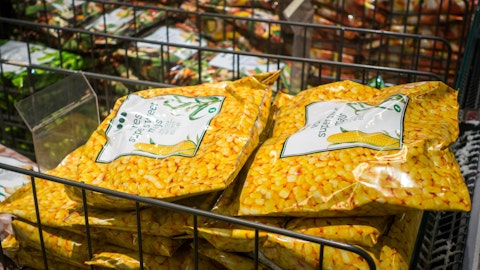Scott Mushkin: Perfect. Thanks guys. Thanks for taking my questions.
Sandy Douglas: Thank you, Scott.
Operator: Your next question comes from the line of Kelly Bania from BMO Capital Markets. Your line is open.
Kelly Bania: Good morning. Thanks for taking our questions. Just wanted to ask again about the procurement gains. I think the — one of the challenges with that has been just the visibility into how that has impacted the P&L. So I guess at this point, have you been able to go back and do some more analysis that gives you confidence in the magnitude of procurement gain headwinds that you have forecasted in fiscal ’24. And then, I have a couple more follow.
Sandy Douglas: I think principally Kelly, we do, because we have now experienced Q3 and Q4 of last year. And we have the ability now with all of that data to triangulate in on the data sources that we have and project it forward for Q1 and Q2. And the numbers John described in his script are how that’s weighing on the P&L for fiscal ’24. I would go further to say that we have learned from that a lot about how our margin operates through our distribution systems and that’s helping us create value, not just forecast.
Kelly Bania: Okay. And can you give us any color on the specific dollar amount and pacing of the return of promotions and what is baked into your guidance and how that compares to these (ph) historical levels of margin that you generate from promotional activity?
Sandy Douglas: Sure, Kelly. This answer is going to frustrate you. But you may have some more information than I do on this. What we’re seeing is we’re seeing suppliers talk about accelerating promotions. Their actions are slightly behind their words. But because of the fact that inflation is coming down and unit velocity is not matching it on a one-to-one basis, it’s logical to us that we will see supplier promotions improve and that’s what we believe they saying. It’s what they’re telling us. But it looks to be gradual and it may be a function of fiscal years and how next year, which most of the suppliers are calendar fiscal, will begin. But from a supplier perspective, we’re seeing it slowly increase, but it’s still below pre-pandemic levels.
From a retailer perspective, we’re seeing promotions accelerate as retailers look to drive their price positioning, particularly those that are price-positioned. But as suppliers get more promotional, we are here to help them get a return and to invest more.
Kelly Bania: Okay. That’s helpful. And maybe just within your guidance, can you talk a little bit more about the retail profitability that took a pretty big leg down here? And maybe can you talk about the factors? Is that, is that, is that, your own retail stepping up their own promotions. And I guess in similar vein, what does your guidance assume in terms of customer mix-shift pressures?
Sandy Douglas: Well, listen, when you look at our retail business, which is I think about 10% of our business, we have an extraordinary brand franchise in Cub, which is the market leader in the Twin Cities area. Twin Cities is a typical U.S. market and it’s prone to all the challenges that we see across the country. Reducing federal assistance, student loans coming back. There’s plenty of pressure on the consumer. There is also a significant amount of price competition in the market and we’re seeing that it’s a big market for — home market for one discounter. It’s a big market for another and we’re seeing all kinds of competitive activity. So our team has doubled down on that and they are investing in promotions to try to retain and grow their customer count.
And then, they are also experiencing higher than pattern labor expenses. So that’s impacted their profitability. From a more broad standpoint, and our outlook for our retail business is incorporated in our guidance. So but that brand — the Cub brand is a strong brand and we expect it to succeed going forward. As it relates to kind of market shifts, there is clearly pressure in the market coming from discounters. They’re investing and they are taking share. And that’s evident in the syndicated data. What our job is to try to make sure that our independence and our customers in general are equipped with the best cost, the best promotional investments, and programs to help them compete effectively, and to outperform their peer set first, and to gain share in the market.
And many of them are. Many of them are doing very well. I would say sales in general are soft at this stage, and we’re going to continue to work to try to outperform the market. But our guidance incorporates that kind of an outlook.
John Howard: And Kelly, just one reminder, the FY ’23 retail incurred — it reflects the expenses to open those six stores that I mentioned in my script, that we would not expect to repeat in FY ’24.
Kelly Bania: Did you share a number on that, John?
John Howard: I don’t think we’ve disclosed that number externally. But it will be — for all six stores, it will be a few million dollars.
Kelly Bania: Okay. And maybe I can just squeeze in one more here on capex. And if you are willing to comment at all on how that might play out over the next several years as we work towards this automation and optimization process. We’ve had capex go here from $250 million to $320 million, and now planned at $400 million. So should that continue to creep up in the out years?




